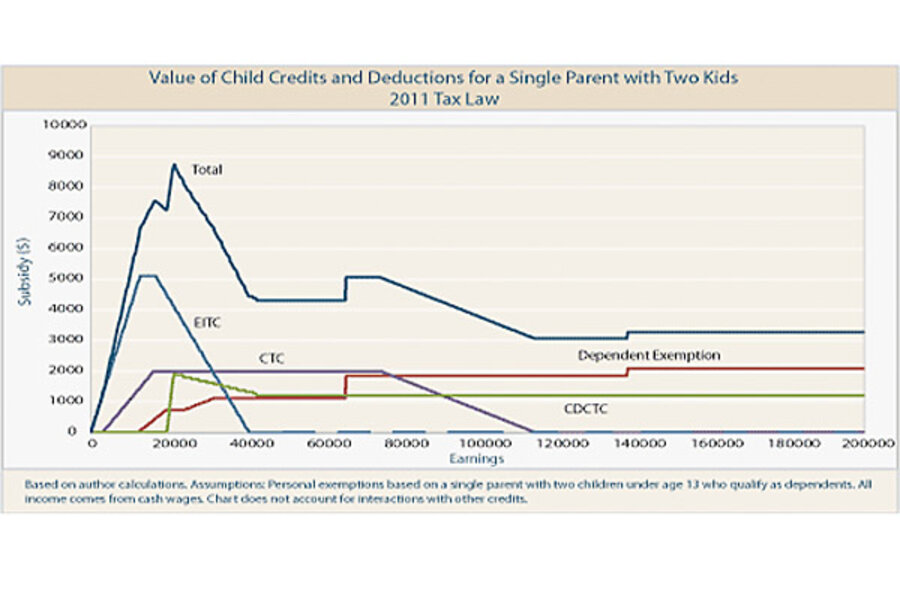Many tax breaks for kids, but do they work together?
Loading...
Tax credits and deductions provide substantial assistance to families with children at all income levels. However, the value of tax provisions varies sharply depending on how much the family makes, whether the parents work or are married, how many children they have, their kids’ ages, and whether they attend college. In our new guide, “A Reference Manual for Child Tax Benefits,” my Tax Policy Center colleagues Stephanie Rennane, Gene Steuerle, and I demystify the bewildering complexity of how families qualify for these subsidies and who benefits from each provision.
Child tax provisions phase in and out erratically (see graph). For instance, if you’re a single mother with two children who gets all of her income from wages, the value of tax credits and deductions rise rapidly and then plunge dramatically after your earnings hit about $25,000. The pattern of benefits is very different, however, for the largest child provisions—the Earned Income Tax Credit (EITC), Child Tax Credit (CTC), and dependent exemption.
TPC estimates that more than 20 million families claimed $53 billion in earned income credits on their 2010 tax returns. Most of the money went to low-income working families. (No work, no credit!) Benefits increase with wages to a maximum of $3,094 for families with one child, $5,112 for families with two children, and $5,751 for families with three or more children, and then phase out at higher earnings levels. An estimated 54 percent of benefits went to families with incomes in the lowest quintile (or fifth) of the income distribution, below about $12,000, and another 42 percent went to families in the second quintile with incomes below about $23,000.
In contrast, the child credit provides a bit less money overall—but to many more families. Nearly 35 million households received $52 billion in benefits. And while low-income families receive limited benefits, almost two-thirds of the subsidy accrued to those making above about $23,000 (the middle fifth of families and above).
The dependent exemption disproportionately benefits even higher-income families. Because it reduces taxable income, the exemption cuts taxes most for those facing the highest rates. During the 2010 filing season, it will cut taxes by an estimated $38 billion for 48 million families. The poorest get virtually nothing, while over 80 percent of benefits go to the top 60 percent of families.
With the federal budget under enormous pressure, policy makers must spend limited dollars to maximum effect. Understanding how the child-focused credits fit together—or don’t—and recognizing who benefits from them, is a good starting point for lawmakers seeking to reform the tax code with fairness and efficiency in mind. For simplicity, they might even want to consider creating a uniform definition of child, which might facilitate future reform efforts.
Add/view comments on this post.
--------------------------
The Christian Science Monitor has assembled a diverse group of the best economy-related bloggers out there. Our guest bloggers are not employed or directed by the Monitor and the views expressed are the bloggers' own, as is responsibility for the content of their blogs. To contact us about a blogger, click here. To add or view a comment on a guest blog, please go to the blogger's own site by clicking on the link above.





